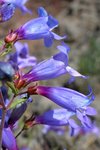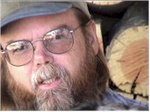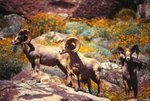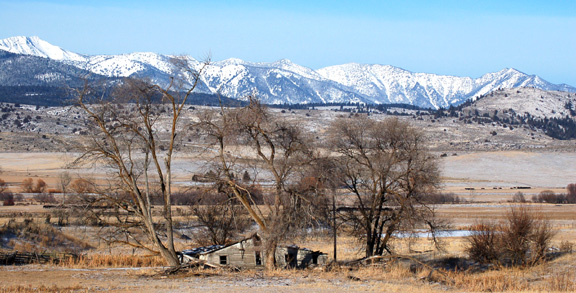In This Issue:
- Baker Bighorns "Blinking Out"
- Bob Beschta & "Lords of Nature" in Baker City Tonight & Tomorrow
- Hillary Clinton Validates a "Jewish State" in Palestine (Hmmmmmmm)
_________________
Baker Bighorns "Blinking Out" - Payette National Forest Bighorn Plan
 Bighorn Ram (photo from ODFW)
Bighorn Ram (photo from ODFW)Our Hells Canyon bighorn sheep are suffering severe population declines from contact with domestic sheep that were, and are, presently allowed to be in the proximity of domestic sheep on public forest lands in the Payette National Forest across the river in Idaho.
According to "Bighorn Sheep in Hells Canyon: Historical Background and the Hells Canyon Bighorn Sheep Restoration Project,"Originally published in the summer 2002 issue of Wild Sheep Magazine, the official publication of the Foundation for North American Wild Sheep (Tim Schommer):
Rocky Mountain bighorn sheep were native in much of the mountain and canyon country, which currently comprises northeast Oregon and western Idaho. Historical accounts indicate that bighorns were numerous in and around Hells Canyon, main Salmon River, and the Wallowa Mountains. The Nez Perce Tribe has written that bighorns were the most plentiful large animal in the big river canyons of northeastern Oregon and west Idaho prior to European settlement.See this article's title link above for more. . .
The archeological records in Hells Canyon shows that the Nez Perce people had an extended and extensive history of using bighorn sheep. We know they constructed stone corrals for the capture and containment of bighorns and stone blinds for hunting. They used the animals for their meat, hides for warmth, and the horns for spoons (ewes) and bow making (rams). Most petroglyphs and pictographs in Hells Canyon depict scenes of hunters and bighorn sheep. Bighorn sheep were a significant ungulate food item as well as of great cultural value to the Nez Perce Tribe in Hells Canyon.
As European people settled the west, many of the activities either directly or indirectly had a negative impact on native bighorn sheep populations. In Hells Canyon, settlers quickly claimed every flat area with good soil, especially near the water. They brought with them flocks of cattle, horses, and domestic sheep. The flat areas were irrigated and turned into hay fields, while large gardens and orchards were adjacent to their homes.
Domestic herds grazed most of the year on adjacent “Unclaimed Lands” (now mostly public lands). The mild climate in Hells Canyon usually provided year-round grazing. Most homesteaders greatly increased the size of their flocks to take advantage of free grazing and increase revenue. Grazing soon became out of control and severely damaged soil, vegetation, and water quality. One settler wrote in 1901 that if he was not the first one to get to the grass after the snowmelt, they got none there the rest of the year (Langston, 1995). Range wars were common, especially between cattle and sheep producers. By the turn of the century, the situation demanded desperate measures. In 1905, Teddy Roosevelt convinced Congress to establish the National Forest Reserves. The main purpose of the reserves was to stop uncontrolled grazing and timber harvest, and improve and sustain quality soil and water conditions. Also in 1905, the Wallowa Cheifton reported there were over 300,000 domestic sheep in Wallowa County (northeast Oregon), most of which grazed on National Forest. . . . .
Unregulated hunting, competition for forage with domestic livestock, and parasites and diseases introduced by domestic livestock were all factors which lead to the elimination of bighorns in Hells Canyon. Today, research has shown that pneumonia caused by a biotype of bacteria called Pasteurella, which is transmitted from domestic sheep to bighorns, was the principal reason for the disappearance of bighorns in Hells Canyon and throughout most of the western United States (Martin et. al., 1996).
Recently, a Baker City neighbor told me about the abundant bighorn population, as well as viewing and photography opportunities that existed down in Hells Canyon from below the Hells Canyon Dam to the Sheep Mountain area of Oxbow Reservoir and around Brownlee Dam. After a futile search recently for these bighorn, I spoke with the Oregon Department of Fish and Wildlife (ODFW) to see if I could improve my chances. That’s when I learned just how bad things had become since I’d seen my first Hells Canyon bighorn 8 or 9 years ago.
According to ODFW, the Sheep Mountain population is on the verge of “blinking out” and there were only six or so bighorn left in the Hells Canyon Dam area, which I believe is the “Upper Hells Canyon” population. ODFW had recently completed their winter bighorn minimum population census and found that there were only about nine sheep left in the Sheep Mountain herd, falling to this level from a high of 87 animals in 1999, after the initial transplant of 30 animals in 1991. ODFW indicated since disease issues related to domestic sheep allotments started in 1999, only 2 offspring have survived, with most dying within a month or two of birth.
According to a 2006 report by the Payette National Forest, Risk Analysis of Disease Transmission Between Domestic Sheep and Bighorn Sheep on the Payette National Forest, bighorn sheep are dying in the Hells Canyon area because of disease transmitted by domestic sheep, kept, and herded by, a few sheep allotment permittees on the Payette National Forest. The report states:
Perhaps the most important reason bighorn sheep populations have recovered poorly is that bighorn populations have been negatively affected by disease to a much greater extent than have populations of other wild ungulates such as mule deer and elk (Goodson 1982). Bighorn sheep is a New World species closely related to domestic sheep (Ovis aries). Domestic sheep, an Old World species, has likely evolved resistances to important diseases as a result of domestication
and intense artificial selection. Because they are so closely related, bighorn sheep are thought to be highly susceptible to diseases carried by domestic sheep.
An extensive body of scientific literature on the effects of disease on bighorn populations has accumulated. The literature indicates the following:
1) numerous examples of bighorn die-offs due to disease have been documented;
2) bighorn die-offs were documented as early as the mid 1800s and have been documented in every state in the western U.S.;
3) bighorn die-offs typically follow known or suspected contact with domestic sheep;
4) under experimental conditions, clinically healthy bighorn sheep have developed pneumonia and died within days to weeks following contact with clinically healthy domestic sheep;
5) a variety of diseases and pathogens have been implicated in die-offs, but most commonly the disease implicated in the die-off is bacterial pneumonia (Pasteurellosis) caused by Mannheimia haemolytica (formerly Pasteurella haemolytica) or other species of closely related Pasteurella bacteria;
6) there is consensus among wildlife biologists and veterinarians experienced in bighorn sheep management that
domestic sheep and bighorn sheep must be kept separated in order to maintain healthy bighorn populations (e.g., Foreyt and Jessup 1982; Goodson 1982; Onderka and Wishart 1988; Foreyt 1989; Desert Bighorn Council Technical Staff 1990; Callan et al. 1991; Cassirer et al. 1996; Martin et al. 1996; USDI Bureau of Land Management 1998; Bunch et al. 1999; Singer et al. 2000a, 2000b, 2000c, 2000d; Monello et al. 2001; Schommer and Woolever 2001; Singer et al. 2001; Dubay et al. 2002; Garde et al. 2005).
So, once again, the American people are sacrificing their wildlife heritage for the profit of a few public lands grazing permittees, their employees, and any taxes to be derived therefrom, minus the huge costs associated with managing the allotments.
Comments were due today on the updated Payette National Forest draft supplementary environmental impact statement on their plans for management of domestic sheep allotments in the area inhabited by bighorns.
You will have an opportunity in the future to comment on the final supplementary environmental impact statement. With regard to the draft, I sent them the following hurried comments, such as they are:
March 22, 2010
Christopher Christie
1985 15th Street
Baker City, OR 97814
refugee2000@gmail.com
541-523-2376
Suzanne C. Rainville
Forest Supervisor
Payette National Forest
Attn: Bighorn Sheep Comments
800 W. Lakeside Ave.
McCall, ID 83638
payettebighorn@fs.fed.us
Re: Draft Supplemental Environmental Impact Statement on Bighorn Sheep Viability—Comments
Dear Supervisor Rainville:
These are my comments on the Payette National Forest’s (“PNF”) Draft Supplemental Environmental Impact Statement on Bighorn Sheep Viability (“DSEIS”).
I cooperate with the Hells Canyon Preservation Council (HCPC), the Western Watersheds Project (WWP), and the Oregon Natural Desert Association (ONDA). I am aware of the views of HCPC and WWP and agree with their view that Alternative 7E should be selected. I have read the comments by Debra Ellers and the WWP. I agree with and support those comments.
Since my early youth, I have been fortunate to become acquainted with bighorn sheep through observation while traveling in the western U.S. and Canada. I have been concerned about their viability and ultimate survival since becoming aware of the struggles for survival of endangered Peninsular bighorn sheep during my years in California.
In 2001 or 2002, while on a jaunt to Hells Canyon from Prairie City, Oregon, I encountered a collared and bedraggled looking ewe on a trail along the rim in what was the Mc Graw herd area. While aware of disease transmission between domestic sheep, other livestock, and bighorns at the time, I had no idea of the tragedy that had been inflicted on the re-introduced Hells Canyon populations, including the McGraw herd, through contact with domestic sheep in the 1990’s and earlier parts of this decade.
After I moved to Baker City, my neighbor told me about the abundant bighorn population and opportunities viewing and photographing them down in Hells Canyon from below the Hells Canyon Dam to the Sheep Mountain area of Oxbow Reservoir and around Brownlee Dam. After a futile search recently for these bighorn, I spoke with the Oregon Department of Fish and Wildlife (ODFW) to see if I could improve my chances. That’s when I learned just how bad things had become since I’d seen my first Hells Canyon bighorn 8 or 9 years ago.
According to ODFW, the Sheep Mountain population is on the verge of “blinking out” and there were only 6 or so bighorn left in the Hells Canyon Dam area, which I believe is the “Upper Hells Canyon” population. ODFW had recently completed their winter bighorn minimum population census and found that there were only about nine sheep left in the Sheep Mountain herd, falling to this level from a high of 87 animals in 1999, after the initial transplant of 30 animals in 1991. ODFW indicated since disease issues started in 1999, only 2 offspring have survived, with most dying within a month or two of birth.
After reading the Risk Analysis of Disease Transmission Between Domestic Sheep and Bighorn Sheep on the Payette National Forest, (Payette National Forest, February 6, 2006), it appears that contact with domestic sheep on allotments or driveways within the Payette National Forest, is responsible for these unnecessary population declines.
According to the observational narrative in the report on pp. 7 and 8, some animals in the McGraw herd were crossing over to the Idaho side domestic sheep allotments and becoming sick from pneumonia. It also says that the McGraw herd began dying in the fall of 1999, and that two of them had also been observed mingling with Oregon’s Sheep Mountain herd that year, the year the Sheep Mountain herd die-off began. (The assumption being that the individuals from the McGraw herd could have transmitted the disease contracted originally from domestic sheep, to the Sheep Mountain herd.
Figure 3-6, Telemetry Data and Observations of Bighorn Sheep near the Payette National Forest, on p. 3-16 of the recent Update to the DSEIS (Update), confirms that two modes of transmission are possible: One of direct contact between bighorn and domestic sheep, and another of inter-herd re-transmission from bighorn to bighorn.
Evidence that inter-herd mixing of bighorns is fairly common and widespread between far-flung herds can be seen in the telemetry data represented in Figure 3-6. The data represented there, also suggests that the Upper Hells Canyon bighorns could have contracted disease by contact with domestic sheep on the sheep driveway that existed in previous years on the western slope of Cuddy Mountain in Idaho, after having crossed over at Brownlee Dam, with subsequent infection of the bighorns of the Sheep Mountain herd. The Update also states on p. 2-14, that” In addition, bighorn sheep foray in and out of domestic sheep allotments located on the Payette NF, often returning to the HCNRA.”
These things lead me to believe that the Payette National Forest (PNF) should choose Alternative 7E, which would not allow domestic sheep grazing or trailing routes within the PNF, because that alternative offers the best chance for maintaining bighorn viability and compliance with the National Forest Management Act (NFMA).
There is also other information in the Update that clearly points to Alternative 7E being the reasonable, rational, and legally supportable choice:
- It is the only alternative that prevents interspecies contact, thus preventing re-initiation of disease cycles from the original and major source for disease transmission. In discussing the Contact Model on p. 2-11, the Update states that “Alternative 7E is the only alternative that prevents interspecies contact,” which eliminates the original and recurring source of the disease problem. The preferred Alternative 7G does little to remedy the contact problem, as the Update admits on p. 2-11: “Alternatives 1B257, 346, 7G and 7L have moderate to high contact rates that involve four to seven of the populations.” Over half (56%) of the nine alternatives do a better job of preventing contact than the preferred Alternative 7G.
- 7E maximally reduces the probability of external domestic sheep initiated disease outbreaks in the affected herds. In discussing 7E in the Disease Model on p. 2-12, the Update states that “Alternative 7E (no allotments) was not included. The probability of a disease outbreak for all herds under this alternative is 0.” Under even moderate probability of contact assumptions, the preferred Alternative 7G results in a high probability of extirpation for four herds, including Upper Hells Canyon. (Update p 2-12: Under moderate assumptions for contact leading to a disease outbreak; Little Salmon, Main Salmon S. Fk. and Upper Hells Canyon have a high probability of extirpation under Alternatives 1B257, 346, 7G and 7L.)
- In the Update, on p. 2-13, under the heading “Summary and Determinations,” it states: “ Alternative [7]E provides the greatest protection to bighorn sheep habitats, the least likelihood of contact, and the highest probabilities of persistence for all bighorn sheep populations. For bighorn sheep, as a sensitive species, this alternative would have a Beneficial Impact.” This statement reiterates some of the conclusions above, and clearly shows that Alternative 7E provides the best chance for bighorn viability and survival. On the other hand, the preferred Alternative, 7G ranks 6th in “probability for bighorn sheep persistence,” and is one of the alternatives with “the highest risks of contact and protect the least amount of source habitats, [and] would likely not insure bighorn sheep populations on and adjacent to the Payette National Forest. . . .[and also] Will Impact Individuals or Habitat with a Consequence that the Action May Contribute to a Trend Towards Federal Listing or Cause a Loss of Viability to the Population or Species.” (Update p. 3-13)
- On p. 2-16 of the Update, it states that “Alternative 7G eliminates domestic sheep grazing from the Payette National Forest system lands within the boundary of the HCNRA. It also eliminates domestic sheep grazing at least 6 air miles from the boundary of the HCNRA. Only a small sliver of the core herd home range is within suitable area for domestic sheep grazing. Elimination of domestic sheep grazing in HCNRA and surrounding area is compatible with the HCNRA Act and its implementing regulations by providing for the protection, restoration, and maintenance of bighorn sheep and their habitat.” This last statement, as it applies to 7G, does not appear to be true because telemetry and other data in the Update shows that the bighorn in question travel much further on their forays than 6 miles, which would likely lead to further disease transmission. Even WAFA recommends a 9 mile buffer. Additional disease transmission hardly qualifies for protection of bighorn under the act. The Update also notes on p. 3-73 that: “Keeping an adequate spatial buffer between bighorn sheep and domestic sheep is the most reliable method of preventing contact between these species (Desert Bighorn Council Technical Staff 1990, Schommer and Woolever 2001, Singer et al. 2001), but spatial buffers are not always adequate given the distances bighorn sheep rams will travel (Wehausen et al., unpublished data). Clifford et al. (2009) recommended that if eliminating the risk of interspecies contact (thereby eliminating the probability of respiratory disease transmission to bighorn sheep from domestic sheep) is a management goal, at a minimum, domestic sheep grazing should not occur within the known population utility distribution of the bighorn sheep.”
- On p. 2-16 of the Update, it also states that “Alternative [7]G is in compliance with the HCNRA CMP by maintaining a separation between bighorn and domestic sheep that is likely to keep the two species apart at the current population levels. If the population levels of bighorn sheep increase, the likelihood of contact may increase and this evaluation may need to be revisited.” First, I found no evidence in the update that supports the first assertion, even at current population levels (please point it out if it is there). Additionally, keeping the populations at their current depauperate levels can hardly be seen as complying with the HCNRA Act or “its implementing regulations by providing for the protection, restoration, and maintenance of bighorn sheep and their habitat.” It is already clear that some populations, like the Sheep Mountain population are doomed to extirpation in the short term. Restoration implies an expansion of at least some populations, so dealing with the eventuality is best addressed by Alternative 7E, not by promising to revisit the subject at some future date.
- On p. 2-16 of the Update, with reference to 7G, it also states that “Monitoring should be conducted to assess future locations of bighorn sheep and assure no contact occurs with domestic sheep on permitted allotments.” Yes, on most livestock allotments, monitoring “should” be conducted, but it rarely is adequate because of USFS budgets. Clifford et.al. (2009) state: Husbandry practices such as removing domestic sheep well before the onset of rut, following vigilant herd management to reduce strays, and responding to wandering bighorn sheep, are other methods to separate the species and reduce risk, but extensive monitoring efforts are required and are not always effective (DSEIS IDT and Cooperators 2007, 2008).” I think everyone can agree that “monitoring efforts are required and are not always effective.”
- The economic analysis of portion of the Update on beginning on p. 3-89, particularly that under the heading “Income, from Sheep and Lamb Production in Idaho,” p. 3-92&94, while interesting, seems woefully inadequate, and/or irrelevant in many areas. The analysis needs to focus on the income (including income of the permittees), and taxes, derived from the use of the allotments in question, not on what comes from some counties or the whole state. It should also focus on actual use, not permitted use. It should compare the economic benefits of the sheep allotments to all the costs, including program administration cost, environmental rehabilitation costs, and to the loss of recreational tourist dollars in both Oregon and Idaho (among other costs), and show them clearly in a table, so that readers don’t become lost in pages of seemingly irrelevant statistics.
Having started very late on these comments, there is simply no time left for more of them. Again, I agree with HCPC and WWP that Alternative 7E should be implemented by the Payette National Forest to best provide for bighorn protection, viability, and restoration.
Thank you for consideration of these comments. Please keep me on your mailing list for any further communications, and particularly, the Final SEIS.
Sincerely,
Christopher Christie
 Endangered Peninsular Bighorn Sheep, 1998
Endangered Peninsular Bighorn Sheep, 1998__________
Bob Beschta & "Lords of Nature" in Baker City Tonight & Tomorrow
Talks on March 24 in Baker City and in Enterprise
The Wallowa-Whitman National Forest is hosting a talk on "Carnivores and Sustainable Ecosystems", by Oregon State University Professor Emeritus, Dr. Bob Beschta, on Wednesday March 24 at two locations and times:
Baker City - 9:00 a.m., Whitman Ranger District, 3285 11th Street.
Enterprise - 3:00 p.m., Wallowa Mountains Office, 88401 Highway 82.
Dr. Beschta has taught and conducted research on a wide range of natural resource issues related to forest and rangeland ecosystems for over 36 years. Since 2001, his research has focused on the role of large predators and trophic cascades in western ecosystems. His presentation will summarize the results from six widely separated National Parks, including Yellowstone, where large predator removal/displacement occurred and the potential implications of these results to other public lands in the West.
Each talk will be 45 minutes to one hour long, followed by a 30-minute question and answer period. The public is invited to attend.
For additional information call Suzanne Fouty at 541-523-1944 (Baker City) or Trisha Johnson, at 541-426-5572 (Enterprise).
 photo courtesy of Green Fire Productions
photo courtesy of Green Fire ProductionsLords of Nature Showings March 23rd and 24th
in Baker City and Enterprise.
The film by Green Fire Productions "Lords of Nature: Life in a Land of Great Predators" will be shown in:
Baker City on Tuesday March 23rd at the Eltrym Theatre (1809 1st Street) at 7 pm
Enterprise on Wednesday March 24th at the OK Theatre (208 W. Main St.) at 7 pm
Both showings will be followed by a panel discussion, with:
Dr. Bob Beschta, Oregon State University
Russ Morgan, Oregon Dept. of Fish & Wildlife (ODFW)
Jesse Timberlake, Defenders of Wildlife
Gary Miller, US Fish & Wildlife Service (USFWS)
Both screenings are free and open to the public.
photo courtesy of Green Fire Productions
__________
Israel's occupation of Palestine:
Hillary Clinton Quote While on Annual Pilgrimage to AIPAC (American Israeli Political Action Committee Conference on March 21, 2010
". . . we are determined to keep moving forward along a path that ensures Israel's future as a secure and democratic Jewish state living in peace with its Palestinian and Arab neighbors." -Hillary Clinton at AIPAC Conference, march 21, 2010"
Can you imagine what what the response would be from the mainstream media and others if a white gentile Christian leader had suggested to Americans that "we are determined to keep moving forward along a path that ensures America's future as a secure and democratic Christian state living in peace with its neighbors"?
Some articles showing basic responses to the subject of America as a Christian state or nation:
ADL Urges Sen. McCain to Withdraw Statements Describing U.S. as a 'Christian Nation'
New York, NY, October 1, 2007 … The Anti-Defamation League (ADL) today urged Senator John McCain to reconsider and withdraw his statements describing the United States as a "Christian nation" and a "nation founded on Christian principles." The remarks were made in an interview posted on Beliefnet.com.
"Senator McCain's statements were disappointing and disturbing to say the least," said Abraham H. Foxman, ADL National Director. "We would have thought that a senator as experienced and respected as John McCain would place himself above such divisive appeals to religious intolerance. His remarks were inaccurate and ill-advised for any candidate seeking to lead a nation as religiously diverse as ours."
In a letter to Senator McCain, ADL said that he was correct to note in the interview that the Founding Fathers unequivocally believed in the separation of church and state.
However, the letter went on to say, "Absolutely nothing in the Constitution establishes that the U.S. is a Christian nation, nor is it accurate to say that this nation was founded on Christian principles." The League called on McCain to reconsider and withdraw his statements to that effect.
"Appeals to voters based on religion are invariably divisive and contrary to the democratic ideals upon which our nation was truly founded," the letter said.
As a 501(c)(3) tax-exempt charitable organization, ADL is non-partisan and does not endorse or oppose any candidates for political office.
The Anti-Defamation League, founded in 1913, is the world's leading organization fighting anti-Semitism through programs and services that counteract hatred, prejudice and bigotry.
--
January 22, 2009, 6:38pm
Obama and the Christian-Muslim-Jewish Nation
By Nathan Guttman
One staple of any great speech is that everyone hears it in a different way. For some, President Obama’s inaugural address was all about hope and optimism; for others, it was about the nation’s resilience. For the Zionist Organization of America’s Morton Klein, it was all about one sentence: “We are a nation of Christians and Muslims, Jews and Hindus and non-believers.”
Turns out that it’s all about the sequence, and Klein, the ZOA president, feels that Jews were unfairly downgraded to third place. In a press release, Klein reads into Obama’s decision to put Muslims before Jews (and Hindus and non-believers) in his speech.
“Throughout its history, the United States has always been known as a nation based on Judeo-Christian values and heritages,” he argues, quoting former president Bush’s 2001 inaugural address in which he put “synagogue” before “mosque.”
According to Klein, it is not a matter of prestige but of numbers, and since Jews outnumber Muslims in the United States, they should rightly hold on to their second place. “This is not a Muslim-Christian-Jewish nation, it is a Judeo-Christian nation,” he told the Forward.
But if numbers and sequence do matter, here is a point Jewish observers who are worried about Islam beating Judaism for second place in the president’s eyes, should look at: A day after the inauguration, Obama attended the national prayer service, and guess what: There were three rabbis and only one Muslim representative.
--
Is America a Christian nation, as many conservatives claim it is? One American doesn't think so. In his press conference on April 6 in Turkey, President Obama explained: "One of the great strengths of the United States is … we have a very large Christian population -- we do not consider ourselves a Christian nation or a Jewish nation or a Muslim nation. We consider ourselves a nation of citizens who are bound by ideals and a set of values."
--
This next article distinguishes between a state and a nation:
The United States of America is not a Christian country or state. The writers of the Constitution said, very wisely, that "Congress shall make no law respecting an establishment of religion, prohibiting the free exercise thereof." In other words, there will be no state church (such as the Church of England), but the people may worship according to their wishes, anytime and anywhere. A "country" is a geographical area inhabited by a certain people under a particular political government.
However, the United States of America is a Christian nation. A nation is an aggregation of people bound together "by common ideals and a common purpose. A rich inheritance of memories and the desire to preserve those memories ... a nation is a spiritual entity brought into existence by complex historical conditions, by similar traditions and a similar imagination."
--
NPR: Debating America's Christian Character
by BARBARA BRADLEY HAGERTY
--
OP-ED CONTRIBUTOR
A Nation of Christians Is Not a Christian Nation
By JON MEACHAM
Published: October 7, 2007
Correction Appended
JOHN McCAIN was not on the campus of Jerry Falwell’s Liberty University last year for very long — the senator, who once referred to Mr. Falwell and Pat Robertson as “agents of intolerance,” was there to receive an honorary degree — but he seems to have picked up some theology along with his academic hood. In an interview with Beliefnet.com last weekend, Mr. McCain repeated what is an article of faith among many American evangelicals: “the Constitution established the United States of America as a Christian nation.”
___
The Last Resort
Don Henley
"The Eagles", from "Hell Freezes Over" album, 1994
Go to this link to View:
http://www.youtube.com/watch?v=qlszpoz6O-Y











